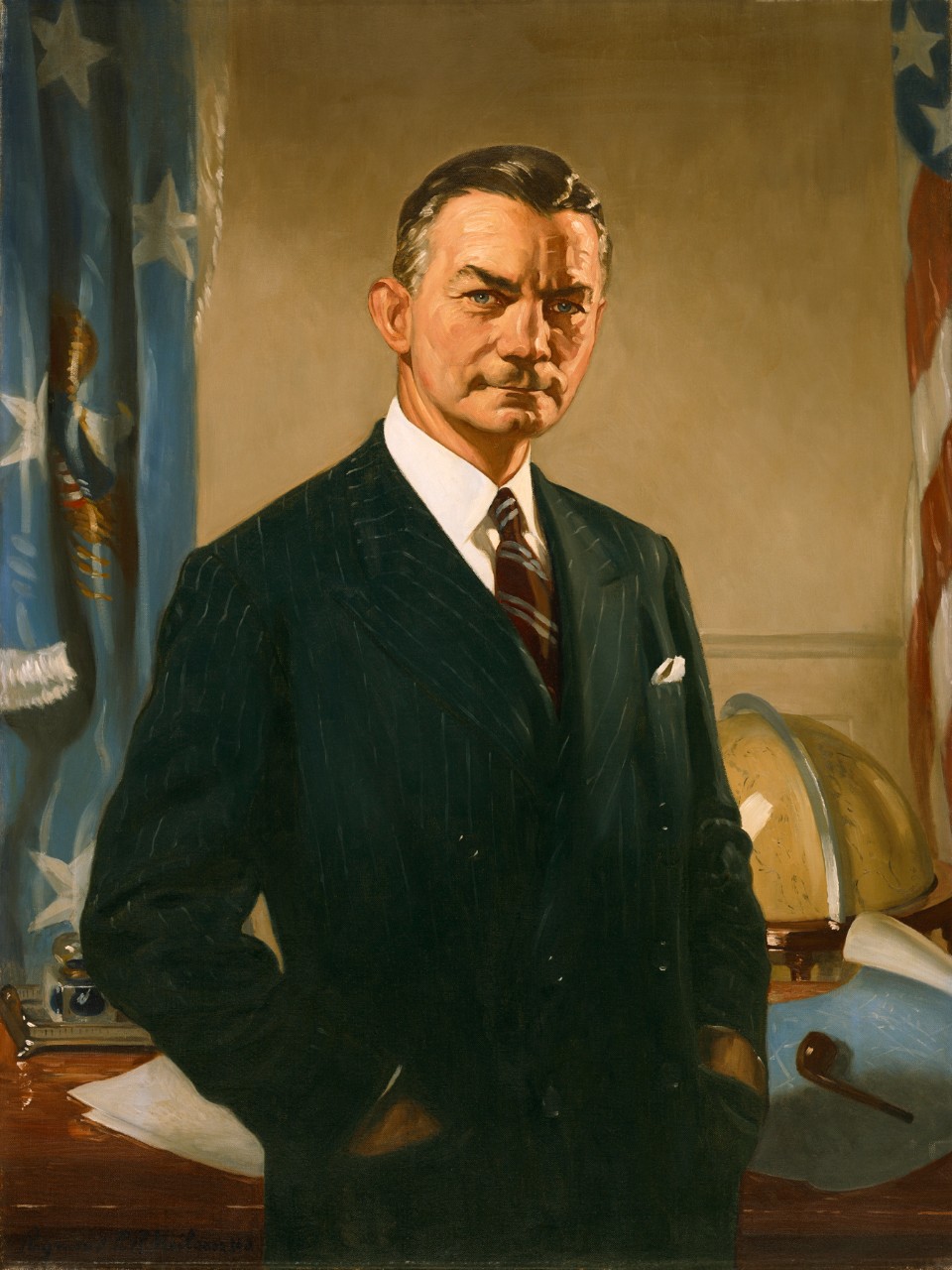James V. Forrestal
15 February 1892 – 22 May 1949

James Vincent Forrestal was born on 15 February 1892, in Matteawan (now Beacon), New York. After he graduated from high school, Forrestal worked for three years at local newspapers in New York before he began school at Dartmouth College in 1911. The following year, he transferred to Princeton University, but left in 1915 a few credits short of his degree, apparently due to academic and financial difficulties. He then worked as a financial reporter, clerk for a zinc company, and bond salesman. Shortly after the United States entered World War I, Forrestal enlisted in the U.S. Navy as a seaman second class. While in the Navy, Forrestal was enthused by naval aviation and took flight training from the British Royal Flying Corps. He was commissioned an ensign and earned his pilot’s wings soon thereafter. After World War I ended, Forrestal was discharged from the Navy and returned to banking. He met Josephine Ogden, and the couple soon married. They had two sons, Michael and Peter. The marriage ultimately ended due to irreconcilable differences.
In June 1940, Forrestal accepted a position as a special assistant to President Franklin D. Roosevelt, serving as a liaison in handling the National Defense Program (part of the country’s rearmament efforts as it prepared for possible entry into World War II). Later that year, the president nominated Forrestal to fill a new position as Under Secretary of the Navy. Secretary of the Navy William F. “Frank” Knox assigned him to handle contracts, taxes, and legal affairs, and serve as a liaison with several other government agencies. A highly capable administrator and manager, Forrestal built his office into an efficient organization, and he effectively ran the Navy's machinery for industrial mobilization and procurement, a vast system that ultimately produced the largest fleet ever to put to sea. The seemingly tireless under secretary made numerous trips across the country and to numerous battlefields, coming under fire by the Japanese more than once during inspection and morale-building tours on Kwajalein and Iwo Jima. When Secretary Knox died of a heart attack, Forrestal succeeded him on 19 May 1944. He guided the Navy through the last year of the war and into the two difficult years of demobilization after the Japanese surrendered.
During late June/early July 1946, Forrestal visited Joint Task Force 1 at Bikini Lagoon in the Marshall Islands for Test Able—part of Operation Crossroads—to witness the detonation of an atomic bomb and its effects on more than 90 ships. The massive explosion stunned Forrestal, and he made a number of references during interviews over succeeding days to the tremendous power unleashed by the blast. Complex global problems confronted the nation during the Cold War, and planners developed a new national security system. Forrestal participated prominently in the development of the National Security Act of 1947, even though he initially opposed it. Nonetheless, under pressure from President Harry S. Truman and others, Forrestal and Secretary of War Robert P. Patterson played a prominent role in shaping the initial form of the act. As part of the act, the position of Secretary of Defense was created. Although the president preferred the Secretary of War for the position, Patterson declined, wanting to return to private life. Truman subsequently selected Forrestal as the first Secretary of Defense.
Forrestal soon discovered that perhaps the chief obstacle to accomplishing his objectives as defense secretary would be the inherent weakness of the position’s powers as defined in the National Security Act. Moreover, national security issues plagued his tenure as secretary, and the defense budget became a source of tension between Forrestal and the president. Due to public pressures to limit defense expenditures and his predilection for a balanced budget, Truman would not agree to budget levels proposed by Forrestal. In addition, disagreements between the services over roles and missions complicated the matter.
For all the problems he had as defense secretary, Forrestal could list some solid accomplishments in his first report in December 1948. These included the formulation of long-range and short-range strategic plans, the development of an integrated defense budget for Fiscal Year 1950, the definition of service roles and missions, the coordination of service procurement efforts, and the establishment of additional overseas unified commands. Forrestal acknowledged that the mere passage of the National Security Act did not mean that its objectives would come overnight. The most difficult part of the task of unification was to bring conflicting ideas into agreement. The 1949 amendments to the National Security Act stand as testimony to Forrestal’s determination to improve the Department of Defense structure. The 1949 amendments began the legislative process of clarifying and expanding the powers of the Secretary of Defense. Centralization of authority in the Office of the Secretary of Defense became a constant objective under Forrestal and many of his successors.
Forrestal struggled with recurring bouts of despair, hopelessness, and widely erratic mood swings that caused him to resign on 28 March 1949. Psychiatrist Dr. William Menninger of the Menninger Clinic of Topeka, Kansas, diagnosed him with reactive depression—a disorder then commonly identified among veterans returning from the fronts. Although Menninger recommended that Forrestal enter his clinic for treatment, Navy officials dispatched Captain George N. Raines, the chief psychiatrist at the U.S. Naval Hospital in Bethesda, Maryland, and he successfully petitioned that Forrestal should enter the Washington, DC, suburb hospital instead. However, while at Bethesda, he continued to experience further attacks of depression and took his own life on 22 May 1949.
The country acknowledged his services to American security and freedom through two world wars by interring Forrestal with full military honors at Arlington National Cemetery three days later. The Finnish artist Kalervo Kallio sculpted a bronze bust of Forrestal that officials unveiled at the mall entrance to the Pentagon on 22 September 1950.
Aircraft carrier USS Forrestal (CVA-59) that operated extensively during the Vietnam War and in Operation Desert Storm was named in his honor.


